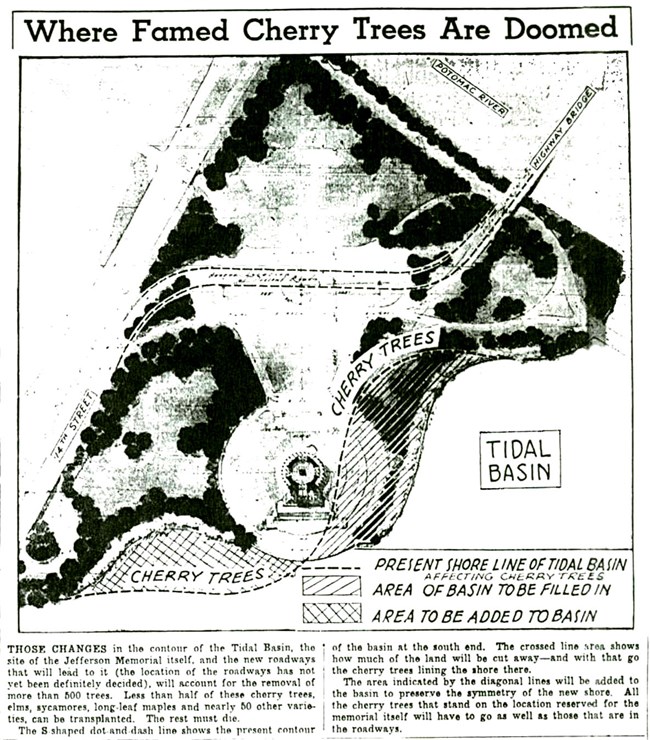Last updated: March 14, 2018
Article
The Cherry Tree Rebellion

The Washington Herald
"The Cherry Tree Rebellion" of November 1938 was the final battle in a prolonged campaign to prevent construction of the Thomas Jefferson Memorial in Washington, DC. From its inception in 1934 the project had been mired in controversy. Many felt the timing was wrong for a costly memorial while the nation was in the deadly grip of the Great Depression. In addition, the Jefferson Memorial Commission's direct selection of John Russell Pope as the architect, without holding an open design competition, angered many in the architectural community, who accused the memorial commission of playing favorites. At the same time, Pope was increasingly regarded by a younger generation as a design dinosaur, out of step with trends in modern art and architecture. Finally, the memorial commission's preference for Pope's gigantic, Roman-style temple in the center of the Tidal Basin, was perceived by numerous Washingtonians as a direct threat to the beauty of the Japanese cherry trees.
By the fall of 1938, thanks largely to the determined support of President Franklin Roosevelt (FDR), all of the obstacles thrown in the path of the Jefferson Memorial Commission had seemingly been overcome. The new location on the south shore had been confirmed, Pope's Pantheon design had been scaled-down (resulting in a reduced threat to the trees) and appropriations secured to begin construction. However, when a National Park Service press conference on November 10, 1938, suggested "approximately 600 trees of various kinds" would be " involved" in order to build the memorial, opposition once more roared to life.
The leader of this opposition was the powerful Washington newspaper owner, Eleanor "Cissy" Patterson. Editorials in Patterson's two daily newspapers, the Times and the Herald, had increasingly grown critical of FDR's policies. She resented the administration’s measures to reform big business and feared the nation might become involved in another European war. The press conference, with its suggestion that the government was reneging on its earlier pledge that few trees would be harmed, provided the colorful Patterson with fresh ammunition to attack President Roosevelt, and his beloved memorial project. If FDR wanted a Thomas Jefferson Memorial, "Cissy" Patterson would lead the "save the trees" campaign to stop it.
Following the National Park Service press conference, Patterson's newspapers railed against the destruction of the Japanese cherry trees along the Tidal Basin. Patterson published a front-page story detailing how the National Capital Park & Planning Commission, lead by Roosevelt's uncle, Frederic A. Delano, had been tricked into supporting the project. Time, however, was running out. Construction was scheduled to begin shortly after Thanksgiving, and once construction began all opposition would be mute. The issue quickly came to a head in mid-November.
On Thursday morning, November 17, 1938, Patterson hosted a rally at her Dupont Circle mansion for Washington, DC society women opposed to the destruction of the trees. Following the meeting, more than 80 women marched to the White House to present FDR with a petition to save the trees. However, when presidential secretary, Marvin McIntyre, emerged instead to accept the petition, he was treated to a chorus of angry women chanting the Joyce Kilmer poem "Trees."
The following morning, Friday, November 18, a small army of approximately 150 women arrived at the future construction site. The protesters quickly disrupted the efforts of the Civilian Conservation Corps workers attempting to transplant the trees, by wrestling away shovels and symbolically chaining themselves - and a U.S. Park Police sergeant - to the trees, leading to a temporary suspension of work.
Meanwhile, President Roosevelt at his morning press conference suggested " It is one of the most interesting cases ... of a flimflam game being started by the owner of a paper" and threatened to have the women transplanted along with the trees. Upon learning of the president's refusal to back down, the women retreated. However, that evening "Cissy" Patterson would blast FDR with a front-page editorial taking the president to task for fibbing about the number of trees that would have to be destroyed. Construction would begin the following month with President Roosevelt attending a simple ceremony.
Dedicated on April 13, 1943, the bicentennial of the birth of its namesake, the Thomas Jefferson Memorial would serve as a shining symbol of freedom during World War II and beyond.
